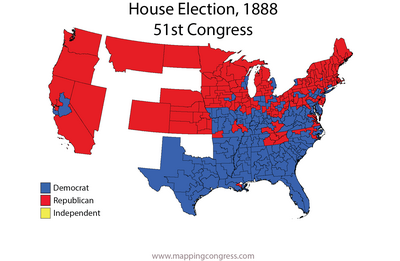
The 1876 United States presidential election was the 23rd quadrennial presidential election, held on Tuesday, November 7, 1876, in which Republican nominee Rutherford B. Hayes faced Democrat Samuel J. Tilden. It was one of the most contentious presidential elections in American history. Its resolution involved negotiations between the Republicans and Democrats, resulting in the Compromise of 1877, and on March 2, 1877, the counting of electoral votes by the House and Senate occurred, confirming Hayes as President. It was the second of five U.S. presidential elections in which the winner did not win a plurality of the national popular vote.

The 1888 United States presidential election was the 26th quadrennial presidential election, held on Tuesday, November 6, 1888. Republican nominee Benjamin Harrison, a former Senator from Indiana, defeated incumbent Democratic President Grover Cleveland of New York. It was the third of five U.S. presidential elections in which the winner did not win the national popular vote, which would not occur again until the 2000 US presidential election.

The Solid South or the Southern bloc was the electoral voting bloc of the states of the Southern United States for issues that were regarded as particularly important to the interests of Democrats in those states. The Southern bloc existed between the end of the Reconstruction era in 1877 and the passage of the Civil Rights Act of 1964. During this period, the Democratic Party overwhelmingly controlled southern state legislatures, and most local, state and federal officeholders in the South were Democrats. During the late 1800s and early 1900s, Southern Democrats disenfranchised blacks in all Southern states, along with a few non-Southern states doing the same as well. This resulted essentially in a one-party system, in which a candidate's victory in Democratic primary elections was tantamount to election to the office itself. White primaries were another means that the Democrats used to consolidate their political power, excluding blacks from voting in primaries.

The 1888 United States House of Representatives elections were held for the most part on November 6, 1888, with three states holding theirs early between June and September. They occurred at the same time as the election of President Benjamin Harrison. Elections were initially held for 325 seats of the United States House of Representatives, representing 38 states, to serve in the 51st United States Congress. Six new states would later join the union and increase the House to 332 seats. Special elections were also held throughout the year.

The Electoral Commission, sometimes referred to as the Hayes-Tilden or Tilden-Hayes Electoral Commission, was a temporary body created by the United States Congress on January 29, 1877, to resolve the disputed United States presidential election of 1876. Democrat Samuel J. Tilden and Republican Rutherford B. Hayes were the main contenders in the election. Tilden won 184 undisputed electoral votes, one vote shy of the 185 needed to win, to Hayes' 165, with 20 electoral votes from four states unresolved. Both Tilden and Hayes electors submitted votes from these states, and each claimed victory.
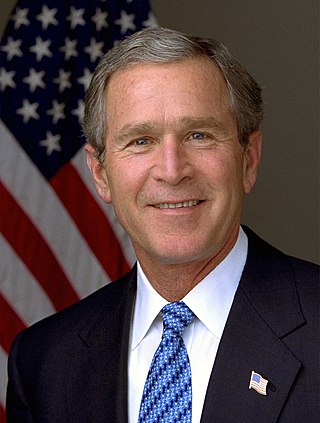
The 2004 United States presidential election in South Dakota took place on November 2, 2004, and was part of the 2004 United States presidential election. Voters chose three representatives, or electors to the Electoral College, who voted for president and vice president.
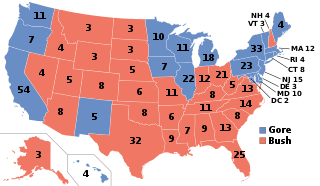
The 2000 United States elections were held on November 7, 2000. Republican Governor George W. Bush of Texas defeated Democratic Vice President Al Gore of Tennessee in the presidential election. Republicans retained control of both houses of Congress, giving the party unified control of Congress and the presidency for the first time since the 1954 elections.

The 1996 United States elections were held on November 5. Democratic President Bill Clinton won re-election, while the Republicans maintained their majorities in both houses of the United States Congress.

The 1888–89 United States Senate elections were held on various dates in various states, coinciding with Benjamin Harrison's victory over incumbent President Grover Cleveland. As these U.S. Senate elections were prior to the ratification of the Seventeenth Amendment in 1913, senators were chosen by state legislatures. Senators were elected over a wide range of time throughout 1888 and 1889, and a seat may have been filled months late or remained vacant due to legislative deadlock. In these elections, terms were up for the senators in Class 2.

The 1876 United States elections were held on November 7. In one of the most disputed presidential elections in American history, Republican Governor Rutherford B. Hayes of Ohio ended up winning despite Democratic Governor Samuel J. Tilden of New York earning a majority of the popular vote. The Republicans maintained their Senate majority and cut into the Democratic majority in the House.

The 1988 United States elections were held on November 8 and elected the President of the United States and members of the 101st United States Congress. Republican Vice President George H. W. Bush defeated Democratic Governor of Massachusetts Michael Dukakis. Despite Dukakis' defeat, the Democratic Party built on their majorities in Congress.

The 1968 United States elections were held on November 5, and elected members of the 91st United States Congress. The election took place during the Vietnam War, in the same year as the Tet Offensive, the assassination of Martin Luther King, Jr., the assassination of Robert F. Kennedy, and the protests of 1968. The Republican Party won control of the presidency, and picked up seats in the House and Senate, although the Democratic Party retained control of Congress.
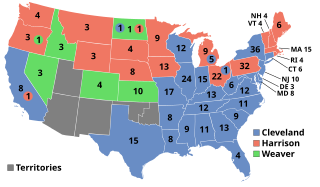
The 1892 United States elections was held on November 8, electing member to the 53rd United States Congress, taking place during the Third Party System. Democrats retained the House and won control of the presidency and the Senate. Following the election, Democrats controlled the presidency and a majority in both chambers of Congress for the first time since the 1858 elections.

The 1884 United States elections were held on November 4, electing the members of the 49th United States Congress. The election took place during the Third Party System. The Democratic Governor Grover Cleveland of New York defeated Republican Secretary of State James G. Blaine in the presidential election. In Congress, the Republicans retained control of the Senate while Democrats maintained control of the House of Representatives. This marks the last election in U.S. history in which the Democratic president came to office without unified control of Congress.
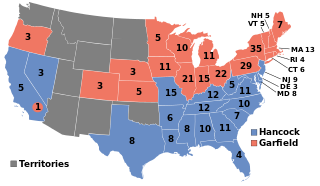
The 1880 United States elections occurred during the Third Party System, and elected the members of the 47th United States Congress. Republicans retained the presidency and took control of the House. An unclear partisan situation prevailed in the Senate. As the first presidential election after the end of Reconstruction, this election saw the first occurrence of the Democratic Party sweeping the Southern United States; the party would carry an overwhelming majority of Southern states well into the 20th century.

The 1860 United States elections elected the members of the 37th United States Congress. The election marked the start of the Third Party System and precipitated the Civil War. The Republican Party won control of the presidency and both houses of Congress, making it the fifth party to accomplish such a feat. The election is widely considered to be a realigning election.

The 1848 United States elections elected the members of the 31st United States Congress and the 12th president of the United States. The election took place during the Second Party System, nine months after the Treaty of Guadalupe Hidalgo ended the Mexican–American War. With the issue of slavery dividing the nation, the Free Soil Party established itself as the third most powerful party in Congress. California joined the union before the next election, and elected its first Congressional delegation to the 31st Congress. Whigs won the presidency, but Democrats won a plurality in the House and retained control of the Senate.

The 1840 United States elections elected the members of the 27th United States Congress, taking place during the Second Party System. In the aftermath of the Panic of 1837, the Whigs become the fourth party in history to win control of the presidency and both houses of Congress; the Whigs would never again accomplish this feat. The election also marked the first time since the 1834 elections that the Democratic Party did not control the presidency and both chambers of Congress.
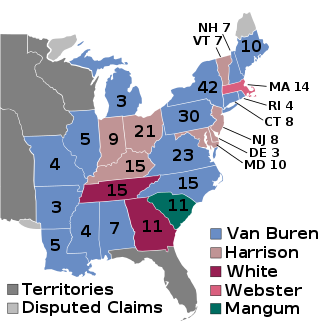
The 1836 United States elections elected the members of the 25th United States Congress. The election saw the emergence of the Whig Party, which succeeded the National Republican Party in the Second Party System as the primary opposition to the Democratic Party. The Whigs chose their name in symbolic defiance to the leader of the Democratic Party, "King" Andrew Jackson, and supported a national bank and the American System. Despite the emergence of the Whigs as a durable political party, Democrats retained the presidency and a majority in both houses of Congress.

The 1824 United States elections elected the members of the 19th United States Congress. It marked the end of the Era of Good Feelings and the First Party System. The divided outcome in the 1824 presidential contest reflected the renewed partisanship and emerging regional interests that defined a fundamentally changed political landscape. The bitterness that followed the election ensured political divisions would be long-lasting and facilitated the gradual emergence of what would eventually become the Second Party System. Members of the Democratic-Republican Party continued to maintain a dominant role in federal politics, but the party became factionalized between supporters of Andrew Jackson and supporters of John Quincy Adams. The Federalist Party ceased to function as a national party, having fallen into irrelevance following a relatively strong performance in 1812.

